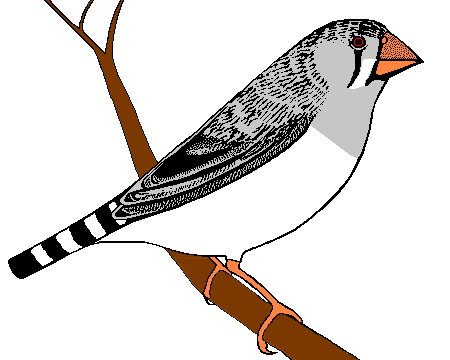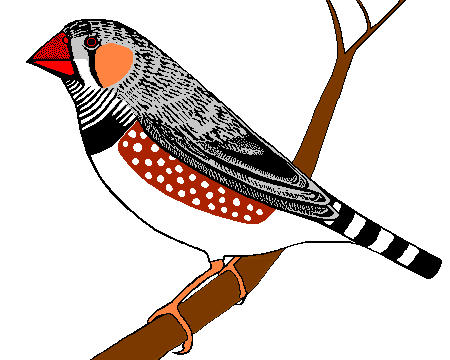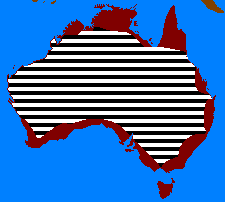

The Australian Zebra Finch is a small bird measuring about 11 centimeters (4,5") and weighing some 12 grammes, which owes its name to the fine black and white barring on the breast and the wider bars of the tail feathers. The female can only be recognized by its tear markings and the aforementioned tail bars, whereas the non-seasonal plumage of the male additionally shows dark orange cheek patches (cheek lobes), horizontal black and white barring continuing down to a chest band at least 3 mm (1/8 in.) wide, and reddish brown side flankings with white spots. Also, the pale orange beak of the hen is coral red in the male who sings his loud courtship song at all times of the year.
Taxonomy: Zebra Finches belong to the family of the "estrildids" (Estrildidae), which are distributed in about 130 species and 49 genera across Africa (south of the Sahara) and Madagascar, South- and Southeast-Asia to New Guinea, Australia and many islands of Oceania. Together with other families (e. g. the true finches, titmice, ravens, swallows, and weaver finches) the estrildids belong to the order of the Passerines or perching birds (Passeriformes) and the suborder Passeres, which in German are called "Singvögel" ('singing birds'). From a human point of view however, waxbills and grass finches (estrildids) do not stand out due to their pretty calls but rather their mostly pretty plumage – hence the German name "Prachtfinken" ('pretty finches').
Zebra Finches exist in two sub-species: The well known Australian Zebra Finch Taeniopygia guttata castanotis is close to our normal or grey colour strain, but preserves the bright red iris which betrays the wild bird in photos. The "nominate race" (Taeniopygia guttata guttata), which was discovered first and lives on the Lesser Sundas and neighbouring
islands north of Australia, is somewhat smaller, the male has a much smaller chest-band and hardly shows any barring on the throat and upper breast. It is presumed that these island Zebra Finches once came from Australia.

Habitat and Distribution: On the "Fifth" or "Red Continent", as Australia is also called, the Zebra Finch is the most common of all the grass finches (estrildids): Apart from the tropical rainforsts and coast of the North East, the cool and humid southern coastal areas and the wooden areas in the east it is widely distributed over the whole continent. There are reasons for that:
As a bird of the open grass land and bush it does cope with the relentless aridity and even the deep temperatures of Australia's continental climate, as long as these don't fall below approximately 6° Centigrade (43° F) or 12° C (54! F) for breeding; but it shuns wetness:
In the tropical north precipitation is too extreme, so that the bird must evade it and fly south in the rainy season; in the south, however, the necessary rain only falls in winter, when it is too cold for breeding. What Zebra Finches need, is moderate rainfalls as they find them at the beginning and end of the rainy season and especially in the dry outback. As the rain there falls only irregularly (and sometimes not at all) the Zebra Finch had to adapt to these imponderables by a high willingness to nest and mobility: it starts courting after the first showers since the grass will flower and produce seeds only a short time later; and if the rain is too long a time in coming the bird has to look for it. This behaviour corresponds with that of the budgerigar – both birds share the same habitat – and explains, why it reproduces so readily: If kept properly, Zebra Finches will find ideal breeding conditions in captivity during the whole year, so they would raise young incessantly there if they were allowed to.
Feeding: Although Zebra Finches can do without water for a long time, they are usually found near the few watering places in the Australian outback. As an ideal adaptation to this situation, they have developed an especially efficient way of drinking: "suck-drinking": The birds do not scoop water time after time, lift their heads and let the water run down their throats; instead, they only shortly dip the bill into the pool and suck the water up and fly off again; predators don't stand a chance!
A Zebra Finch must spend a lot of time searching for food. It lives primarily on grass seeds, which it either picks off the ground or pecks out of grass heads. In the breeding season insects are additionally caught on the ground and in the air.
Social behaviour: Zebrafinches are no loners but very gregarious birds; they live in flocks of 50–100 birds, which are composed of smaller groups of a few pairs. The partners indulge in body contact with each other and their young, only the males in full coloration always keep their distance to each other. The birds brood in colonies, in which only the immediate vicinity of the nests is defended as a territory.
Brooding and Rearing: Sexually mature Zebra Finches mate for life, only death initiates new bonding. During nest construction wild Zebra Finches display an elaborate courtship ritual involving different postures, turning, bowing and hopping and the male's singing; eventually, the female invites the male to mount her by vibrating her tail feathers up and down.
Given the mostly sparse and low vegetation of their steppe habitats Zebra Finches can't be too fussy about choosing a nesting site: They nest in thorny twigs bushes and trees, in tree holes and sometimes even in burrows in the ground! The male lures his partner with soft calls to a possible site, which she will then accept – or not. The spherical nest is predominantly built by the male from rough grass stalks, furnished with soft grass and flower fluff and finally lined with feathers and wool. A typical feature is the entrance on the side, which is protected by a short tube.
The clutch typically consists of five mostly white eggs, which are incubated by both partners; after 12,5 to 16 days the eggs hatch within 36 hours; the nestlings are fed by both parents and leave their nest for the first time after at least 22 days. The fledglings are grey at first but start changing colour rapidly and reach independence at the age of five to six weeks, although their parents will often go on feeding them for some time.
| © 1st Oct 1997 | Australian Experiences |